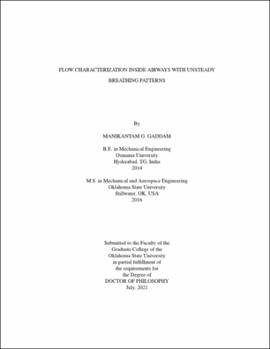| dc.contributor.advisor | Santhanakrishnan, Arvind | |
| dc.contributor.author | Gaddam, Manikantam G. | |
| dc.date.accessioned | 2022-01-21T19:19:50Z | |
| dc.date.available | 2022-01-21T19:19:50Z | |
| dc.date.issued | 2021-07 | |
| dc.identifier.uri | https://hdl.handle.net/11244/333753 | |
| dc.description.abstract | Flow through human airways is characterized by unsteady flows, with flow separations at airway bifurcations. The oscillatory nature of airflow, unequal durations of inhalation time (IT), and exhalation time (ET) can facilitate gas exchange in higher generations of the human airway. Normal respiratory rate (RR) in adults ranges between 10-15 breaths per minute (bpm). RR varies in exercise conditions, mechanical ventilation strategies such as high-frequency oscillatory ventilation (HFOV), metabolic activities and pathological state to facilitate alveolar gas exchange. Previous studies characterized flows at steady inhalation and exhalation through airways. The individual effects of varying inhalation duration and breathing flow rate on flow through airways remains unknown. Our study focuses on various unsteady breathing patterns inside idealized airway models. The goal of this study is to characterize the effects of unsteady internal airflow through idealized airway geometries. Various scenarios of unsteady breathing patterns were simulated in ANSYS software (ANSYS, Inc., Canonsburg, PA, USA) to characterize the fluid dynamics involved in such an unsteady airflow mechanism. The first study includes unsteady breathing patterns such as normal, moderate, and high-frequency ventilation were investigated with variation in inhalation time (IT) to breathing time (BT) ratio. The second study includes abnormal breathing patterns such as tachypnea (~ 1.5x increase in RR), bradypnea (~ 1.5x decrease in RR), hyperpnea (deep breathing with abnormally large peak flow rate), and hypopnea (shallow breathing with abnormally low peak flow rate); and final study includes single nostril inhalation as in yoga pranayama breathing techniques. Simulations were performed for each breathing pattern as in internal airflow studies. Our results showed that secondary flow was an effective transport mechanism for flow inside idealized human airways. Airway local geometry plays a key role in flow distribution in higher generations. Discrepancy in the oscillatory flow relation Re/Wo^2 = 2L/D (L = stroke length; D = trachea diameter) was observed for IT/BT does not equal 50%, as L changed with IT/BT. We developed a modified dimensionless stroke length term including IT/BT. While viscous forces and convective acceleration were dominant for lower Wo, unsteady acceleration was dominant for higher Wo. Time to peak jet length during inhalation increased with an increase in breathing time. Single nostril and double nostril inhalation showed equal ventilation at higher generations in an idealized airway geometry. | |
| dc.format | application/pdf | |
| dc.language | en_US | |
| dc.rights | Copyright is held by the author who has granted the Oklahoma State University Library the non-exclusive right to share this material in its institutional repository. Contact Digital Library Services at lib-dls@okstate.edu or 405-744-9161 for the permission policy on the use, reproduction or distribution of this material. | |
| dc.title | Flow characterization inside airways with unsteady breathing patterns | |
| dc.contributor.committeeMember | San, Omer | |
| dc.contributor.committeeMember | Sallam, Khaled | |
| dc.contributor.committeeMember | Feng, Yu | |
| osu.filename | Gaddam_okstate_0664D_17358.pdf | |
| osu.accesstype | Open Access | |
| dc.type.genre | Dissertation | |
| dc.type.genre | Graphic | |
| dc.type.material | Text | |
| dc.type.material | Moving Image | |
| dc.subject.keywords | bradypnea | |
| dc.subject.keywords | hfov | |
| dc.subject.keywords | hyperpnea | |
| dc.subject.keywords | hypopnea | |
| dc.subject.keywords | tachypnea | |
| dc.subject.keywords | yoga | |
| thesis.degree.discipline | Mechanical and Aerospace Engineering | |
| thesis.degree.grantor | Oklahoma State University | |




